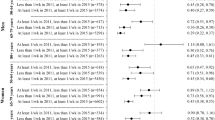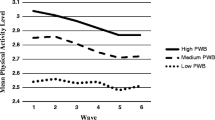Abstract
Background
Although previous studies have associated physical activity (PA) with lower depressive symptoms, the combined effects of the (1) frequency, (2) intensity, and (3) duration of long-term PA have not been examined in detail.
Purpose
We examined the dose–response association between changes in frequency, intensity, and duration of PA and depressive symptoms in men and women over 6 years.
Methods
Participants comprised 1,959 healthy adults (833 men and 1,126 women), aged 24–39 years in 2001, drawn from the ongoing Young Finns Study. PA was assessed using a self-report questionnaire completed in connection with a medical examination in 2001 and 2007. Depressive symptoms were simultaneously assessed using a modified version of Beck’s Depression Inventory in both phases.
Results
High doses of PA at baseline were prospectively associated with fewer depressive symptoms in men, while moderate doses of PA at baseline were inversely associated with the prevalence of depressive symptoms in women. Associations between baseline PA and depressive symptom changes were mediated by social and health-related factors which differed between men and women. Long-term participation in regular PA in all dimensions remained remarkably stable (all p < 0.001). Compared to those who remained inactive, the persistently active participants in all dimensions, with the exception of women’s intensity group, were more likely to show decreases in depressive symptoms independent of the included confounders. An increase in PA in certain groups was also independently associated with fewer depressive symptoms, particularly in women.
Conclusions
Regular and persistent participation in different doses of PA may provide short-term and long-term beneficial effects on depressive symptom changes. The results imply that the moderate to high doses of PA may serve as a buffer against depression in early midlife.

Similar content being viewed by others
References
Moussavi S, Chatterji S, Verdes E, Tandon A, Patel V, Ustun B. Depression, chronic diseases, and decrements in health: results from the World Health Surveys. Lancet. 2007;370:851–8.
Kessler RC, Berglund P, Demler O, Jin R, Merikangas KR, Walters EE. Lifetime prevalence and age-of-onset distributions of DSM-IV disorders in the national comorbidity survey replication. Arch Gen Psychiatry. 2005;62:593–602.
Blumenthal JA, Sherwood A, Babyak MA, et al. Exercise and pharmacological treatment of depressive symptoms in patients with coronary heart disease: results from the UPBEAT (Understanding the Prognostic Benefits of Exercise and Antidepressant Therapy) study. J Am Coll Cardiol. 2012;60:1053–63.
Biddle SJH, Asare M. Physical activity and mental health in children and adolescents: a review of reviews. Br J Sports Med. 2011;45:886–95.
Johnson KE, Taliaferro LA. Relationships between physical activity and depressive symptoms among middle and older adolescents: a review of the research literature. J Spec Pediatr Nurs. 2011;16:235–51.
Mead G, Morley W, Campbell P, Greig CA, Mcmurdo M, Lawlor DA. Exercise for depression (Review). Cochrane Database Syst Rev. 2009;3, CD004366.
Teychenne M, Ball K, Salmon J. Physical activity and likelihood of depression in adults: a review. Prev Med. 2008;46:397–411.
Phillips WT, Kiernan M, King AC. Physical activity as a nonpharmacological treatment for depression: a review. Complement Health Pract Rev. 2003;8:139–52.
Teychenne M, Ball K, Salmon J. Associations between physical activity and depressive symptoms in women. Int J Behav Nutr Phys Act. 2008;5:27.
Azar D, Ball K, Salmon J, Cleland V. The association between physical activity and depressive symptoms in young women: a review. Ment Health Phys Act. 2008;1:82–8.
Chu I-H, Buckworth J, Kirby TE, Emery CF. Effect of exercise intensity on depressive symptoms in women. Ment Health Phys Act. 2009;2:37–43.
Brown WJ, Ford JH, Burton NW, Marshall AL, Dobson AJ. Prospective study of physical activity and depressive symptoms in middle-aged women. Am J Prev Med. 2005;29:265–72.
USDHHS. 2008 Physical Activity Guidelines for Americans. U.S. Department of Health and Human Services. 2008. www.health.gov/paguidelines. 2008.
McKercher CM, Schmidt MD, Sanderson KA, Patton GC, Dwyer T, Venn AJ. Physical activity and depression in young adults. Am J Prev Med. 2009;36:161–4.
Teychenne M, Ball K, Salmon J. Physical activity, sedentary behavior and depression among disadvantaged women. Health Educ Res. 2010;25:632–44.
Dunn AL, Trivedi MH, Kampert JB, Clark CG, Chambliss HO. Exercise treatment for depression: efficacy and dose response. Am J Prev Med. 2005;28:1–8.
Mutrie N, Hannah M. The importance of both setting and intensity of physical activity in relation to non-clinical anxiety and depression. Int J Health Promot Educ. 2007;45:24–32.
Jacka FN, Pasco JA, Williams LJ, Leslie ER, Dodd S, Nicholson GC, et al. Lower levels of physical activity in childhood associated with adult depression. J Sci Med Sport. 2011;14:222–6.
Korniloff K, Vanhala M, Kautiainen H, Koponen H, Peltonen M, Mäntyselkä P, et al. Lifetime leisure-time physical activity and the risk of depressive symptoms at the ages of 65–74 years: the FIN-D2D survey. Prev Med. 2012;54:313–5.
Stavrakakis N, Roest A, Verhulst F, Ormel J, de Jonge P, Oldehinkel A. Physical activity and onset of depression in adolescents: A prospective study in the general population cohort TRAILS. J Psychiatr Rev. 2013;47:1304–8.
Wang F, DesMeules M, Luo W, Dai S, Lagace C, Morrison H. Leisure-time physical activity and marital status in relation to depression between men and women: a prospective study. Health Psychol. 2011;30:204–11.
Heesch KC, Burton NW, Brown WJ. Concurrent and prospective associations between physical activity, walking and mental health in older women. J Epidemiol Community Health. 2011;65:807–13.
Kritz-Silverstein D, Barrett-Connor E, Corbeau C. Cross-sectional and prospective study of exercise and depressed mood in the elderly: the Rancho Bernardo study. Am J Epidemiol. 2001;153:596–603.
Smith PM, Bielecky A. The impact of changes in job strain and its components on the risk of depression. Am J Public Health. 2012;102:352–8.
Raitakari OT, Juonala M, Rönnemaa T, Keltikangas-Järvinen L, Räsänen L, Pietikäinen M, et al. Cohort profile: the cardiovascular risk in Young Finns Study. Int J Epidemiol. 2008;37:1220–6.
Telama R, Yang X, Viikari J, Välimäki I, Wanne O, Raitakari O. Physical activity from childhood to adulthood: a 21-year tracking study. Am J Prev Med. 2005;28:267–73.
Yang X, Telama R, Hirvensalo M, Hintsa T, Pulkki-Råback L, Hintsanen M, et al. Leadership component of type A behavior predicts physical activity in early midlife. Int J Behav Med. 2012;19:48–55.
Mansikkaniemi K, Juonala M, Taimela S, Hirvensalo M, Telama R, Huupponen R, et al. Cross-sectional associations between physical activity and selected coronary heart disease risk factors in young adults. The Cardiovascular Risk in Young Finns Study. Ann Med. 2012;44:733–44.
Haskell WL, I-Min L, Pate RR, Powell KE, Blair SN, Franklin BA, et al. Physical activity and public health: updated recommendation for adults from the American College of Sports Medicine and the American Heart Association. Med Sci Sports Exerc. 2007;39:1423–34.
Hirvensalo M, Telama R, Schmidt MD, Tammelin TH, Yang X, Magnussen CG, et al. Daily steps among Finnish adults: variation by age, sex, and socioeconomic position. Scand J Public Health. 2011;39:669–77.
Beck A, Steer R. Manual for the revised Beck Depression Inventory. TX: Psychological Corp.: San Antonio; 1987.
Elovainio M, Keltikangas-Järvinen L, Kivimäki M, Pulkki L, Puttonen S, Heponiemi T, et al. Depressive symptoms and carotid artery intima-media thickness in young adults: the Cardiovascular Risk in Young Finns Study. Psychosom Med. 2005;67:561–7.
Karsten J, Hartman CA, Smit JH, Zitman FG, Beekman AT, Cuijpers P, et al. Psychiatric history and subthreshold symptoms as predictors of the occurrence of depressive or anxiety disorder within 2 years. Br J Psychiatry. 2011;198:206–12.
Salmela-Aro K, Nurmi J-E. Depressive symptoms and personal project appraisals: a cross-lagged longitudinal study. Pers Individ Dif. 1996;21:373–81.
Katainen S, Räikkönen K, Keltikangas-jarvinen L. Adolescent temperament, perceived social support, and depressive tendencies as predictors of depressive tendencies in young adulthood. Eur J Pers. 1999;13:183–207.
Elovainio M, Kivimäki M, Puttonen S, Heponiemi T, Pulkki L, Keltikangas-Järvinen L. Temperament and depressive symptoms: a population-based longitudinal study on Cloninger’s psychobiological temperament model. J Affect Disord. 2004;83:227–32.
Heponiemi T, Elovainio M, Kivimäki M, Pulkki L, Puttonen S, Keltikangas-Järvinen L. The longitudinal effects of social support and hostility on depressive tendencies. Soc Sci Med. 2006;63:1374–82.
Pulkki-Råback L, Elovainio M, Kivimäki M, Mattsson N, Raitakari OT, Puttonen S, et al. Depressive symptoms and the metabolic syndrome in childhood and adulthood. Health Psychol. 2009;28:108–16.
Lindwall M, Rennemark M, Halling A, Berglund J, Hassmén P. Depression and exercise in elderly men and women: findings from the Swedish national study on aging and care. J Aging Phys Act. 2007;15:41–55.
Sieverdes JC, Ray BM, Sui X, Lee D-C, Hand GA, Baruth M, et al. Association between leisure time physical activity and depressive symptoms in men. Med Sci Sports Exerc. 2012;44:260–5.
Bernard P, Ninot G, Moullec G, Guillaume S, Courtet P, Quantin X. Smoking cessation, depression, and exercise: empirical evidence, clinical needs, and mechanisms. Nicotine Tob Res. 2013;15:1635–50.
Uebelacker L, Epstein-Lubow G, Gaudiano B, Tremont G, Battle C, Miller I. Hatha yoga for depression: critical review of the evidence for efficacy, plausible mechanisms of action, and directions for future research. J Psychiatr Pract. 2010;16:22–33.
Ruo B, Rumsfeld JS, Pipkin S, Whooley MA. Relation between depressive symptoms and treadmill exercise capacity in the Heart and Soul Study. Am J Cardiol. 2004;94:96–9.
Roshanaei-Moghaddam B, Katon WJ, Russo J. The longitudinal effects of depression on physical activity. Gen Hosp Psychiatry. 2009;31:306–15.
De Moor MHM, Beem AL, Stubbe JH, Boomsma DI, De Geus EJC. Regular exercise, anxiety, depression and personality: a population-based study. Prev Med. 2006;42:273–9.
Harvey SB, Hotopf M, Overland S, Mykletun A. Physical activity and common mental disorders. Br J Psychiatry. 2010;197:357–64.
National Association of Chronic Disease Directors. Centers for Disease Control and Prevention and National Association of Chronic Disease Directors. The state of mental health and aging in America issue brief 1: What do the data tell us? Atlanta, GA: Nati.; 2008.
Adults in later life with mental health problems, mental health foundation quoting psychiatry in the elderly (3rd edition), Oxford University Press 2002. Available at: www.mentalhealth.org.uk.; 2002.
Acknowledgments
This study was financially supported by the Academy of Finland [grant nos. 77841, 210283, 123621 (L.P.-R.), 258578 (M.H.), 121584, 124282], Social Insurance Institution of Finland, Ministry of Education and Culture (X.Y.), Turku University Foundation, Special Federal Grants for Turku University Hospital, Research Funds of the University of Helsinki (M.H.), Juho Vainio Foundation (L.P.-R.; X.Y.), Finnish Foundation for Cardiovascular Research, Emil Aaltonen Foundation (M.H.), Alli Paasikivi Foundation (M.H.), Finnish Medical Foundation, Finnish Cultural Foundation, and Yrjö Jahnsson Foundation.
Conflicts of interest
None declared.
Author information
Authors and Affiliations
Corresponding author
Rights and permissions
About this article
Cite this article
Yang, X., Hirvensalo, M., Hintsanen, M. et al. Longitudinal Associations Between Changes in Physical Activity and Depressive Symptoms in Adulthood: The Young Finns Study. Int.J. Behav. Med. 21, 908–917 (2014). https://doi.org/10.1007/s12529-013-9376-0
Published:
Issue Date:
DOI: https://doi.org/10.1007/s12529-013-9376-0




